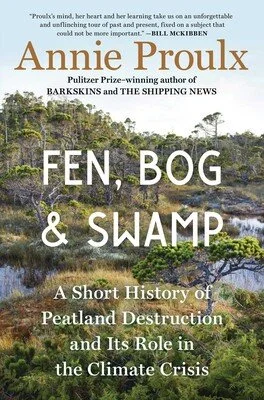Fen, Bog and Swamp by Annie Proulx
The pick for May is a deep dive into wetlands—their history and the ecological consequences of their destruction.
Scribner, 2022, www.simonandschuster.com.
The Sustainability Book Club met on May 4 to discuss Fen, Bog and Swamp: A Short History of Peatland Destruction and Its Role in the Climate Crisis. Written by Pulitzer Prize winner Annie Proulx, this book provides a historical look at some of the vast wetlands that once covered the planet, from their early inhabitants to their eventual draining for agricultural use or residential development.
Proulx offers a dire warning to readers as she explains the vitally important role that wetlands play in our environment. Besides improving water quality, supporting diverse species and protecting against flooding, these areas store huge amounts of methane and carbon dioxide. These greenhouse gases are known to accelerate climate change, and they are released to the atmosphere when wetlands are drained or destroyed.
So what exactly are fens, bogs and swamps? Here is how each is defined in the book:
Fen: A peat-forming wetland that is at least partly fed by waters that have contact with mineral soils, such as rivers and streams flowing from higher ground. Fens support reeds and marsh grasses, and their waters tend to be deep.
Bog: A peat-making wetland with a water source that is not in contact with mineral soil—rainfall. Bogs support sphagnum mosses, and their waters tend to be shallower than fens.
Swamp: A minerotrophic peat-making wetland dominated by trees and shrubs. Swamp waters are shallower than fens and bogs.
Knowing these terms can help us better understand wetlands and communicate to others how their layers of peat sequester greenhouse gases and mitigate climate change.
During the book club meeting, members discussed the most surprising and impactful parts of the book, and two members even gave personal accounts of learning about peat harvesting (and seeing bog bodies!) during visits to Ireland.
A subject of the book that is closer to home, the Great Dismal Swamp, came up as well. This is the largest remaining swamp in the eastern United States. It once covered more than 1 million acres, but today only a fraction of that remains. Protected areas include the nearly 113,000-acre Great Dismal Swamp National Wildlife Refuge in Virginia and North Carolina and the over 14,000-acre Dismal Swamp State Park in North Carolina. Both areas offer wildlife viewing and recreational opportunities.
Book club members also talked about the “swamp” visible from Jake Alexander Boulevard and Harrison Road in Salisbury. This 10.9-acre wetland connects to Grants Creek. A 2019 Salisbury Post article provides a great explanation of why this natural resource is important, including removing pollutants from stormwater runoff, controlling erosion and providing habitat for wildlife.
Pick up a copy of Fen, Bog and Swamp to learn more about this important topic. Then, locate the wetlands near you to make sure they remain protected and preserved for the future.
The Sustainability Book Club
Join a group of avid readers who meet monthly to engage in lively discussions focused on books about sustainability. The club meets at 6:30 p.m. on the first Thursday of every month on Zoom. Contact us to join!
June 1: Wastelands: The True Story of Farm Country on Trial by Corban Addison

